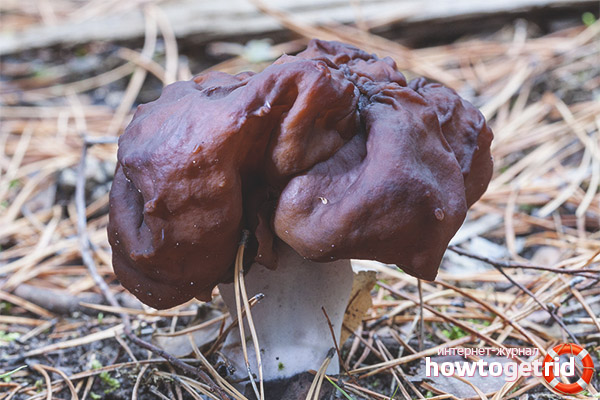The content of the article
When going on a quiet hunt, it is very important to get acquainted with all the varieties of mushrooms that are present in the field of gathering in a timely manner. Today we will consider an interesting instance, called nothing more than an autumn line. Due to its toxicity, the consumption of fruiting bodies in food can cause poisoning, so all important nuances must be taken into account. We will help you with this, let's get started.
View Features
- According to some reports, it is customary to believe that a variety of fruiting bodies is contraindicated for consumption in food. If we consider these mushrooms, taking into account the taste, they are assigned to the fourth category. If you carry out pre-treatment and final thermal cooking in violation of the rules, a person runs the risk of poisoning.
- Now let us briefly characterize the external features by which we can distinguish this representative of the family from all the others. Its apex is velvet in structure, irregular in shape, and varies in color from brown to brownish. It happens in a crease, smoothed or growing to the base.
- In the listed specimens, the leg is pigmented in the same tone as the top. But in some cases, a bluish tint, as well as the presence of a pile, can be observed. The shape of the base is comparable to an elongated cylinder. The pulp quickly breaks due to its fragility, therefore, after harvesting, it is advisable to carefully handle the crop.
- In mushrooms of this variety, the flesh is not secreted by any smell. Regarding the nature of growth, fungi prefer to settle alone, but large colonies can also be found. It is better to engage in gathering from mid-summer until the end of autumn. Mushrooms are not suitable for raw consumption, they are conditionally edible.
- The variety of fruit bodies under discussion is attributed to the lobate genus. Mushrooms are considered the most popular. They got a “fall” note due to the fact that it is necessary to engage in gathering, starting from mid-late summer, ending in autumn (in some southern regions even late). Accordingly, these fungi differ from spring relatives, which crawl to the surface in spring. Also, the differences are also in the fact that the autumn representatives in the composition are much more toxic substances.
Description and growth
- The top in its format is irregular, folded, can grow up to 10 cm wide. It is painted mainly in brown. Over the course of the life cycle, the hat can give more in black tone. Its surface is velvety, and the structure and form itself resembles horns. The upper part adheres to the base. In young animals, the top can be painted in a dark beige tone.
- As for the leg, it is not long enough, grows up to 9 cm. Maximum. This is provided that the thickness is only 1 cm. The base inside is empty, squeezed from the sides, and varies in shade from gray-beige to whitish. The leg is like a cylinder, compacted below, never filled inside.
- The soft section seems to contain cartilage, it is quite fragile and breaks easily. Usually white, but can give off to gray, similar in structure to wax. There is practically no smell.
- From the name it is clear that the peak of growth begins in late summer and lasts all fall. Fungi do not grow colonially, but some manage to find groups of 5-10 specimens. It is necessary to search in deciduous or coniferous strip. Mushrooms settle on rotten wood.
- These mushrooms prefer to settle in the vastness of our homeland, as well as in European countries.Begin to bear fruit in late July, but it is better to go on a quiet hunt in late August.
Spread
- Fruit bodies are more common in Eurasia and North America. Most often, such mushrooms are found in raw pine and mixed forests. In addition, specimens grow well in places of clear-cutting and not far from roads.
- These fruits can occur singly or grow in small groups. Most often this happens on rotting and dead trees. Also, mushrooms are found near such places. Since mid-summer, single specimens can already be found. Closer to the beginning of autumn, active fruiting of lines begins.
Similar views
- The fruiting bodies under consideration have enough external similarities with the red book and dubious line. Such mushrooms are extremely rare and often live exclusively in subalpine and subarctic landscapes.
- At the same time, similar specimens are smaller. The fruiting body has brown-violet tones and fairly large spores.
- In addition, such mushrooms begin to bear fruit only in mid-autumn. Therefore, it is difficult to confuse the instance in question with such a line. Such a mushroom is poisonous and is not used for industrial purposes.
Virulence
- There is no consensus among mushroom pickers how strongly the fruiting bodies in question can be toxic. Therefore, you can find a huge number of opinions about whether it is worth collecting autumn lines and eating them.
- Mycologists refer these fungi to the group of fruiting bodies that contain hemolytic dangerous poison. Such compounds lead to severe consequences of intoxication. Poison is found in high concentration, especially in freshly picked fruits.
- It is enough for a person to eat only a few fruits in order to face serious poisoning. Please note that during the preparation and heat treatment only a small part of toxic compounds is destroyed. Therefore, there remains a high probability of intoxication of the body.
In the modern world, new studies have confirmed that it is better not to collect such mushrooms and even less to eat. With a quiet hunt, it is better to choose other fruiting bodies for yourself, which you can easily cook and enjoy with a calm soul. No need to risk your own health.
Video: autumn line (Gyromitra infula)











Submit